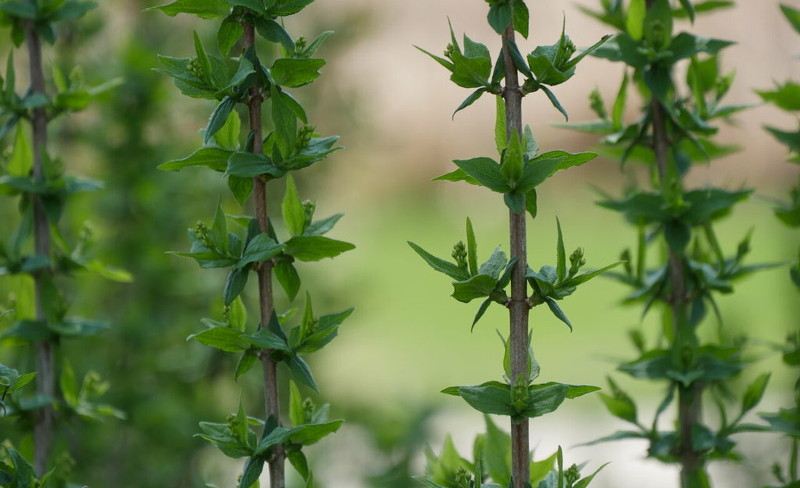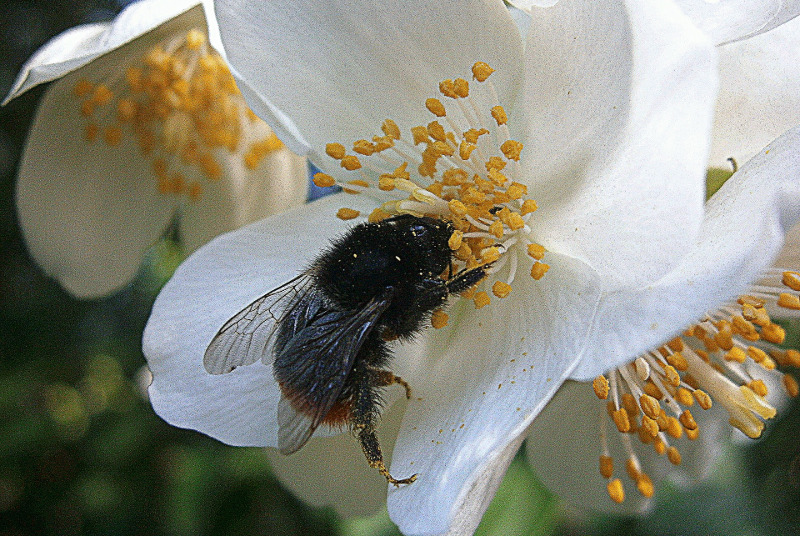Mock Orange (Philadelphus) is a genus of about 60 species of shrubs, native to North America, Central America, Asia and in southeast Europe. USDA hardy in zones 4-7, Mock Orange shrubs bloom in late spring to early summer. This deciduous flower grows from 3–20 ft tall and prefers full sun. Beautiful cup-shaped double white flowers surrounded by oval serrated dark green leaves also have a fragrant citrus smell. Gardeners love to use this plant as a privacy hedge, landscape specimen, or to attract butterflies.

Planting Mock Orange
Mock Orange shrub has a fast growth rate and can grow 2 feet each year. Best planted in the fall, Mock Orange can be planted in the spring as well. For the best blooming, plant in an area that will get at least 6 hours of full sun each day. Tolerating a wide range of soils, make sure the soil is well draining. Adding compost to the soil will help with drainage. Space each plant 20-24 inches apart.
Watering Mock Orange
Mock orange shrubs will need consistent moisture until well established. Somewhat drought tolerant, this plant likes moist, yet not too soggy soil. Regular watering of an inch a week is recommended. Allow the soil to dry out 2 inches down between waterings. During periods of drought, increase the frequency of watering. Mulching around the shrub will help to retain moisture in the soil.

Fertilizing Mock Orange
Prior to planting, mix some manure or compost into the soil. Typically not heavy feeders, you can fertilize Mock Orange annually in the early spring. Use an all purpose fertilizer and water well after application. After that, if the shrub appears to be growing well, no additional feeding is needed.
Pruning Plant Mock Orange
Mock Orange shrubs bloom on previous year’s wood. It is best to prune right after the blooms have faded. This is usually late May or June. Prune off growth just above the outer facing buds. Mature Mock Orange shrubs can become overgrown. Cutting down the oldest one third of branches can encourage newer stems and produce more flowering. Cut these selected branches down to the ground.

Caring For Mock Orange in Pots
The fragrant producing Mock Orange is a popular choice for a container. This fast growing shrub will easily outgrow its pot in one year. Summertime is a good time to re-pot your Mock Orange if necessary.
Choose a much larger container with good drainage holes. Using fresh potting soil transfer the plant and water well after planting. Place the container in an area that will get 6 hours of sun each day. This plant likes consistently moist soil.
Winter Care for Mock Orange
Mock Orange shrubs are deciduous, meaning that they drop their leaves in the winter time. This plant will rebloom each spring. You will need to prepare this plant for the winter months. In the fall, water well before the ground freezes. Mulch around the base of the plant before the ground freezes. This will help protect the shrub’s roots from the cold.
If you choose, you can also cover the plant with a sheet on unusually freezing winter nights. Remove the cover each morning.
Mock Orange For Sale
Common Mock Orange Care Questions
Is Mock Orange Invasive?
Although mock orange is a relatively fast grower, up to 2 feet annually, it is not considered to be invasive.
What To Do After Mock Orange Has Bloomed?
Pruning mock orange is best done right after it is done blooming, late spring/early summer, taking off the tips of new growth and trimming some of the older branches to the ground. This helps encourage new growth and more blooming for the next season. This will help also keep the bush from becoming overgrown, as they grow very quickly, and promote a bushier habitat.
What Is The Size Of Mock Orange?
Some kinds of dwarf mock orange may only be 2 feet tall, while other varieties might reach up to 12 feet high.
What Is The Growth Rate For Mock Orange?
Mock oranges are fast growers and can shoot up more than 2 feet per year.
What Are The Common Problems With Mock Orange Shrubs?
Common pests for the mock orange are aphids, leaf miners. Other common problems are powdery mildew and leaf blight. Both are moisture-driven and can be remedied by protection from too much moisture and making sure they have adequate air circulation.
Have a question about Mock Orange? Fill out the form below and we will try and get back to your question as soon as possible. We may even feature your question on this article to help other gardeners!
 |
Author Chris Link - Published 09-16-2021 |
